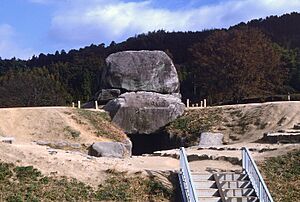Soga no Umako facts for kids
Quick facts for kids
Soga no Umako
|
|
|---|---|
| 蘇我 馬子 | |
| Born | 551? |
| Died | June 19, 626 |
| Resting place | Shimanoshō, Asuka, Nara Prefecture, Japan (traditionally) |
| Monuments | Ishibutai Kofun (traditionally) |
| Other names | Shima no Ōomi (嶋大臣) |
| Years active | late 6th century – early 7th century |
| Known for | Political reforms of Asuka period, associate of Prince Shōtoku, promoter of Buddhism |
| Spouse(s) | Daughter of Mononobe no Ogushi |
| Children | Kahiiko no Iratsume Soga no Emishi Soga no Kuramaro Tojiko no Iratsume Hode no Iratsume |
| Parent(s) | Soga no Iname |
Soga no Umako (蘇我 馬子, 551? – June 19, 626) was a very important leader in ancient Japan. He was a member of the powerful Soga clan, a family that had a lot of influence. Umako helped shape Japan's government and culture during the Asuka period.
He worked closely with Prince Shōtoku, another famous figure. Together, they made big changes to how Japan was run. Umako also played a key role in bringing Buddhism to Japan.
Contents
Who Was Soga no Umako?
Soga no Umako was the son of Soga no Iname, who was also a powerful leader. The Soga clan was one of the most important families in Japan at that time. They often held high positions in the government.
Umako continued his family's tradition of leadership. He wanted to make his clan even stronger. He did this by having his daughters marry into the imperial family. This gave the Soga clan a very close connection to the emperors and empresses.
How Did Umako Change Politics?
Umako worked with Prince Shōtoku to make important changes. These changes happened during the reigns of Emperor Bidatsu and Empress Suiko. They helped create a more organized government.
These political changes helped the Soga clan become very powerful. They had a strong say in many decisions. This was a time when Japan was growing and changing quickly.
Umako and Buddhism
Soga no Umako was a huge supporter of Buddhism. He worked hard to make sure this new religion was accepted in Japan. Buddhism came from China and Korea, and it brought new ideas and ways of thinking.
The Soga clan hired skilled people from China and Korea. These immigrants brought advanced technology and knowledge to Japan. This helped Japan learn new things, including how to build temples.
Building Temples and Spreading Faith
In 587, Umako led his clan to victory in a big battle. This battle was against the Mononobe clan, who did not want Buddhism to spread. Umako's victory made the Soga clan even more dominant. It also cleared the way for Buddhism to grow.
Umako ordered the building of Asuka-dera, one of Japan's first Buddhist temples. On January 15, 593, special relics of Buddha were placed in the temple's foundation. This was a very important moment for Buddhism in Japan.
Umako's Family and Legacy
Soga no Umako's wife was the daughter of Mononobe no Ogushi. She was also the sister of Mononobe no Moriya, the leader Umako defeated. Umako and his wife had five children.
His children also played important roles in Japanese history:
- Soga no Emishi followed in his father's footsteps as a powerful leader.
- Soga no Kuramaro.
- Kahakami no Iratsume became a consort (a type of wife) of Emperor Sushun.
- Tojiko no Iratsume became a consort of Shotoku Taishi.
- Hode no Iratsume became a consort of Emperor Jomei.
Umako's tomb is believed to be the Ishibutai Kofun. This is a large stone burial mound. It shows how important he was in Japanese history.


